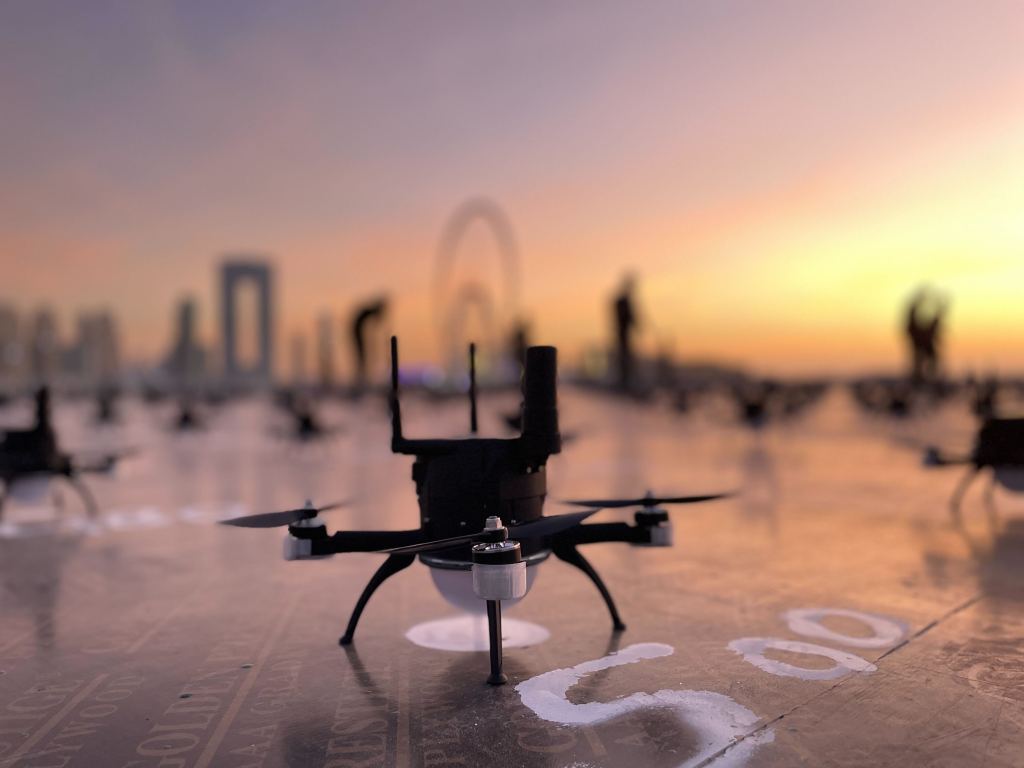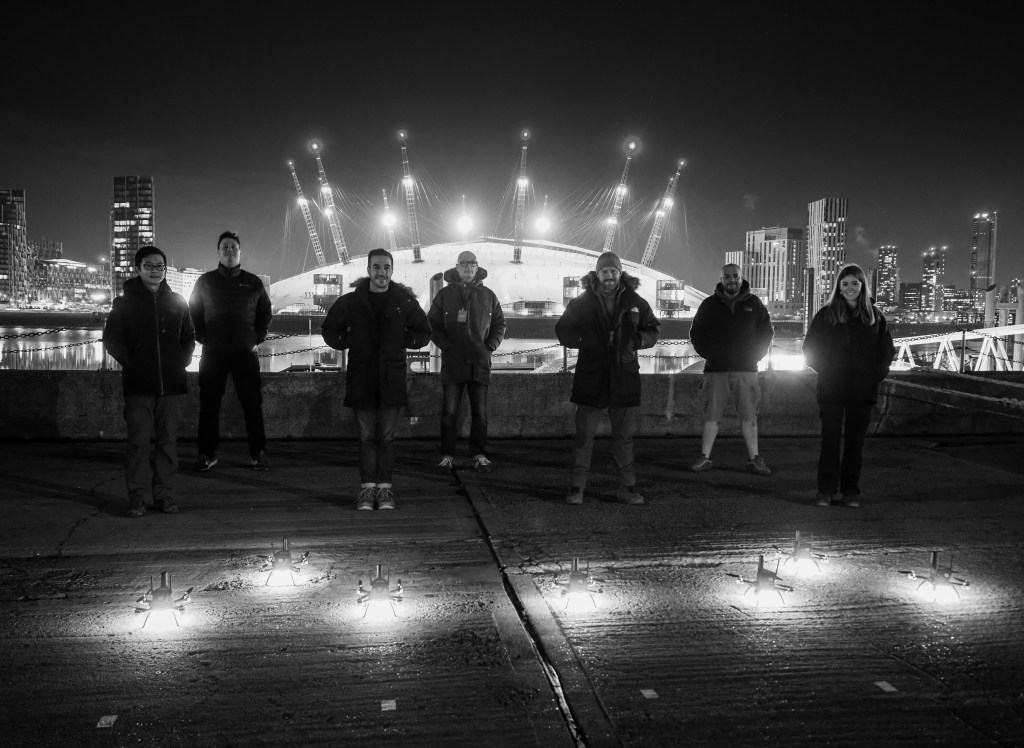
Everyone loves aerial light performances, but few people ever get a backstage peek at what goes into staging the spectacles. To remedy that, UK- and Singapore-based drone show specialist SKYMAGIC sat down with DroneDJ to offer an idea on how those work – and how the company differs from rivals in bringing the skies to life.
SKYMAGIC is fresh off its spectacular drone show that was central to London’s New Year’s Eve extravaganza. Over the past month, meanwhile, it conducted three UAV choreographies twice each night for the Dubai Shopping Festival completing a run of 55 shows. Those performances were scheduled to continue through January, but were grounded amid the United Arab Emirate’s ban on all aircraft operations last week following deadly aerial bombings launched by Houthi militia.
Though its planners have a full slate of clients eager to have their own sky-painted events readied, SKYMAGIC arranged for its associate creative Ollie Howitt to take time out and outline the general contours of what goes into the company’s work.
Launched in 2015, SKYMAGIC produces double-digit drone shows annually – an evolving figure difficult to nail down amid the skyrocketing popularity of the genre over the past couple of years. Howitt says time required to prepare a performance usually averages from two to three months, though the company has turned a few around in just weeks when necessary.
The degree to which themes and imagery involved are set in the client’s mind varies, she says. But no matter the margin of maneuver, SKYMAGIC’s focus is always ensuring UAV formations evoke the show’s story and core themes in the most vivid and compelling manner.
“Whilst we provide guidance from [a] technical point of view, we place [a]ahuge emphasis on the creative,” Howitt explains. “Telling those stories in the sky and guiding clients on what will visually work best is something we love doing, and do really well.”

Once conceptual details are set, she says, the main steps include working up a storyboard, revising those with continual input from clients, and ultimately creating an animated file showing how it will look in the air. Once that’s approved, SKYMAGIC uses the computerized video as the basis for navigation files that will command each drone’s flight.
“The animation is what gets uploaded on the drones, so what you see on the final (video) is exactly what you’ll see when the drones are flying in the sky,” she says.
The next phase is where SKYMAGIC stands apart from most, if not all competitors staging drone shows.
Though it prides itself as a creative specialist, the company also develops and manufactures all its UAVs, as well as tech and software used to navigate the performing swarms. Those in-house 3D-printed production and coding assets give SKYMAGIC full control of the hardware it works with, greater freedom and range of how that’s used, and virtually unlimited capacity when it needs to ramp up its equipment reserves.
Limitations can be imposed, by contrast, by venues chosen to stage the events. Howitt says a minimum 500-square-meter takeoff and landing area is required to facilitate 500 drones in a show. Meanwhile, at least 100 meters of distance must be maintained from buildings, infrastructure, roads, or people not involved with the production – not an easy squeeze to make in London’s Greenwich borough for New Year’s event. In other cases, shapes created have spread over 250 meters wide, occasionally obliging choreography ambitions to be adapted to available spaces involved.

The confounding realities of current battery capacity are another limiting factor. LiPo cells SKYMAGIC uses have 20-minute maximum charges. Those must cover the time swarms lift off, reach their aerial stage, perform, and return – with some just-in-case juice remaining to boot. Because of that, shows are typically kept from 6 to 8 minutes in duration, allowing for the creation of 8 to 10 shapes.
“We find that’s the natural length for a show,” Howitt says, offering a diplomatic description of the modern human’s dwindling attention span as one factor. “Any longer than that and you feel like you’ve seen enough.”
Finally, it’s showtime. With performance plans set, flyable files loaded on to UAVs, and SKYMAGIC staff having checked vehicle placement, condition, and battery charges, the swam is ready to dance. Yet in contrast to the many hours of work put in by more than a dozen people to prepare the performance, oversight of the show itself is assured by just one person, accompanied by a single backup colleague.
Unleashing that burst of celestial activity, meanwhile, requires a similarly whittled-down number of commands: arm drones (propellers spinning); hover and move into grid formation; assume show position; and lights on. From there the pilot largely sits back and watches incoming data flows as the drones put on their show, and return and land themselves when it’s over.
“Essentially, each drone is pre-programmed to fly its own, individual pathway (using) waypoints from the animated file,” says Howitt of the fully automated performance. “As they’re in the air they aren’t speaking to each other – they don’t know where one another is – but fly along their prescribed path. If they deviate from that, that’s where the geo-fencing and the safety protocols come into play.”
She says the use of RTK technology, and the precision that provides, makes any kind of wandering a rarity. That stability in turn assures more vivid images are created in the sky. Safety protocols also ensure that in case any major disruptions occur, the UAVs automatically return to a safe landing area. Were a piloted aircraft to violate the drone show’s authorized space, the SKYMAGIC monitor is equipped with an e-stop command to bring the swarm down immediately.
“We’ve never had to do that,” Howitt notes, “and touch wood we never will.”

She says that no matter how long a drone show takes to prepare, or how many times it’s viewed from the ground, it’s capacity to raise goosebumps among SKYMAGIC staffers never fails.
Yet despite their quickly rising popularity, and reputation for using modern, safe, emissions-free tech, Howitt doesn’t agree with a broadly held assumption that UAVs will inevitably and definitively replace fireworks as the celebratory champion of the skies.
“People seems to view drones and fireworks as an either-or question, but we see it very differently,” she says. “Drones have the ability to tell stories, whereas if you want the huge, climatic, explosive moment, that’s what fireworks do, and we don’t think that will ever go away. With shows like New Year’s Eve… we were working closely on (how) the pyro could really uplift and amplify moments where drones were telling the story.”
And as anyone who has seen that performance knows, the drones, fireworks, and SKYMAGIC pulled that interaction off with the fullest and most pleasing effects.
Top photo: Ben Broomfield
All other photos and videos: SKYMAGIC
FTC: We use income earning auto affiliate links. More.




Comments